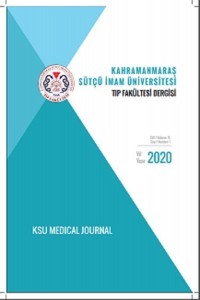Tone-Burst ve Klik Uyarılı İşitsel Beyin Sapı Yanıtları ile İşitsel Uyarılmış Durgun Durum Yanıtları Sonuçlarının Karşılaştırılması
İşitme kaybı, İşitsel Beyin Sapı Yanıtları, İşitsel Uyarılmış Durgun Durum Yanıtları
A Comparison of the Results Measured by Audotory Steady State Responses and Using Frrequency-Spesific Evoked Auditory Brainstem Response
Hearing loss Auditory brainstem responses, Auditory aware static state responses, Otoacoustic emission,
___
- Brookhouser PE, Gorga MP, Kelly WJ. Auditory brainstem response results as predictors of behavioral auditory thresholds in severe and profound hearing impairment. Laryngoscope 1990; 10: 803−10. 3. Kuwada S, Batra R, Maher VL. Scalp potentials of normal and hearing-impaired subjects in response to sinusoidally amplitude-modulated tones. Hear Res 1986; 21: 179−192.4. Lins OG, Picton TW, Boucher BL, Durieux-Smith A, Champagne SC, Moran LM, Perez-Abalo MC, Martın V, Savıo G. Frequency- specific audiometry using steady state responses. Ear & Hearing. 1996; 17: 81–96.5. LJ Hood. Clinical Applications of the Auditory Brainstem Response, Singular Publishing Group Inc., San Diego, London, 1998; pp. 112–142.6. Collet L, Gallego S, Durrant JD, Truy E. Electrically evoked multiple auditory steady-state responses recorded in digisonic cochlear-implanted patients. Oral presentation. International Evoked Response Audiometry Study Group (IERASG). Vancouver, 2001.7. Foster M, Stevens J, Brennan S. Intra and intersubject variability in auditory steady-state response amplitude with high modulation rates to 1000 Hz amplitude modulated and tone pip stimuli. Int J Audiol. 2013 Jul; 52(7): 507-12.8. Luts H, Desloovere C, Kumar A, Vandermeersch E, Wouters J. Objective assesment of frequency-specific hearing threshold in babies. Int J Pediatric Otorhinolaryngol 2004; 68: 915-926.9. Vander Werff KR, Brown CJ, Gienapp BA, Schmidt Clay KM. Comparison of auditory steady-state response and auditory brainstem response threshols in children. J Am Acad Audiol. 2002; 13: 227-235.10. Johnson TA, Brown CJ. Threshold prediction using the auditory steady-state response and the tone burst auditory brain stem response: a within-subject comparison. Ear Hear. 2005; 26: 559-76.11. Aoyagi M, Suzuki Y, Yokota M, Furuse H, Watanabe T, Ito T. Reliability of 80-Hz amplitude-modulation-following response detected by phase coherence. Audiology & Neurootology, 1999; 4: 28–37.12. Kosmider D. Auditory brainstem response and the steadystate evoked potential as predictors of the behavioral audiogram. Unpublished master's thesis. The University of Melbourne, Department of Otolaryngology, Audiology and Speech Sciences. 1997.
- ISSN: 1303-6610
- Yayın Aralığı: Yılda 3 Sayı
- Başlangıç: 2004
- Yayıncı: Kahramanmaraş Sütçü İmam Üniversitesi
Çocukta Serebral Tutulumun Eşlik Ettiği Kardiyak Kist Hidatik: Olgu Sunumu
Aydın TUNÇAY, Ömer Naci EMİROĞULLARI
Hiperlipidemi ve Erektil Disfonksiyon
Hüseyin ÖZTARAKÇI, Saime SAĞIROĞLU, Mehmet Akif KILIÇ
Akılcı İlaç Kullanımı: İlaç Tedavisine Adherans
Yusuf ERGÜN, Duygun ALTINTAŞ AYKAN
Metin KILINÇ, Hatice SAĞER, Eda GANİYUSUFOĞLU, Yeliz DOBOĞLU, Nazlı ÜLKER HANÇER
Diyare ile Başvuran Kırım Kongo Kanamalı Ateşi Olgusu
Hüseyin GÜMÜŞ, Halil KAZANASMAZ
Tüp, İkiz ve Üçüz Bebeklerin TEOAE ve Latans Sürelerinin Karşılaştırılması
